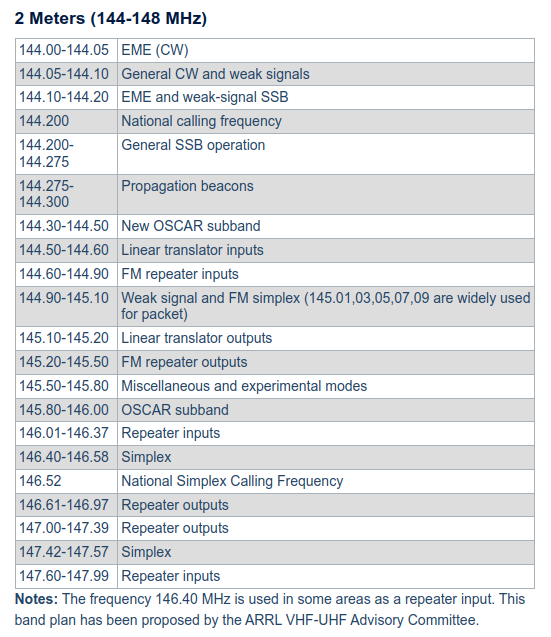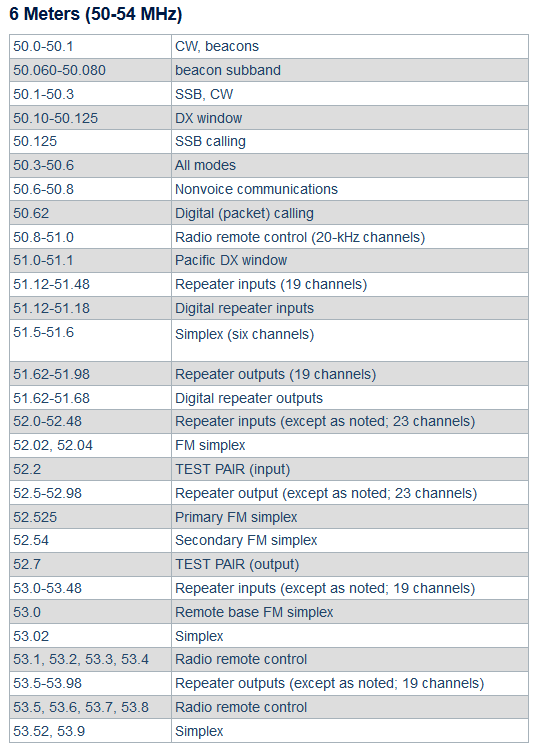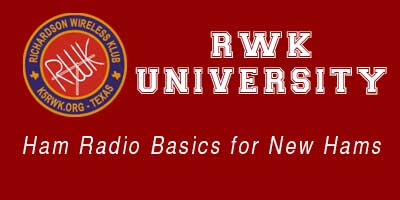Your Technician license lets you do so much more than operate on FM and repeaters. The following shows the full privileges for Technician class operators. There’s quite a bit of spectrum out there that’s available to you to learn and have fun with!

If you look at most of the UHF/VHF bands, you will see that the majority of the band allows all modes (SSB, AM, FM, TV, CW, Digital), but just because the modes are allowed throughout the band, it doesn’t mean that they are used throughout the band. Hams have gotten together and created general agreements that are called Band Plans. These Band Plans give specific guidelines as to what modes are found in what portions of each band, including which fixed frequency “channels” are allocated for repeater operation and simplex FM.
These band plans are a must to promote interoperability and reduction of interference between operators. Let’s take a look at these bands plans a bit more closely…
Two Meters – More than just Repeaters
Operating Modes – Most 2M operations is using FM narrow-band voice (repeaters and simplex operation). Other modes exist and are used (such as “weak signal” work using SSB, Data, CW and even some specialized modes. Most weak-signal work is found at the very bottom of the 2M band. There is a national “calling” frequency at 144.200 – The objective of a calling frequency is that you call on the calling frequency and then move up or down to complete your QSO (freeing up the calling frequency for others). Having a calling frequency means that you only have to listen to one location (as opposed to scanning the entire subband) when operating.
Band Plan – This shows the band plan for the Two Meter band (144-148 MHz). Note: Since Band Plans are “agreements” they are usually specific to a geography or region.

You can see that the top 2 MHz (146-148 MHz) is allocated to FM Repeater and simplex channels. There is also another 1 MHz (144.6 – 145.5 MHz) that provides overflow repeater and simplex channels in congested areas. Between those heavily congested sub-bands, sit the lower 0.5 MHz and an additional 0.5 MHz between 145.5 and 146 MHz. Lets look at those areas and see what’s there!
Weak Signal and EME – Because it’s fairly high in frequency, radios and devices that produce high power levels on 2M are fairly rare. Therefore, most non-FM stations are “weak signal” stations and SSB/CW work on 2M is known as weak signal work and typically occurs at the bottom of the 2M band. A sub-segment of weak signal work is EME – Earth Moon Earth, also known as moonbounce. With a strong enough signal (through a combination of high power and very high gain directional antennas), it’s possible to reflect a radio signal off the surface of the moon and receive it back on Earth!
Satellites – That’s right, Satellites! Because the 2M band is not affected by traditional Ionospheric propagation, the 2M band is the lowest ham band that can reliably be used for satellite “uplink” (it’s also used for downlink on some satellites). We have a whole section on Satellite communications.
Data and Experimental Modes – There is a good amount of packet data around 145.01-145.09MHz, as well as APRS at 144.39MHz. There are also other modes that hams are experimenting with and many are types of digital communications.
Band Characteristics – Each band in the HF spectrum has its’ own “personality”, through a combination of propagation, shared users (some HF bands are partially shared with other services in other parts of the world), and tradition.
Six Meters – The Magic Band
The amateur Six Meter (6M) band is known as the “Magic Band”, and it deserves that name for several reasons. Our 6M band (50-54 MHz) is at the junction of what we consider HF and what we consider VHF, and it shares characteristics of both. Technically, the 6M band is above 30 MHz so it is VHF, but it can be affected by HF propagation as well as some special (magic?) propagation effects. As a Technician, you should get to know Six Meters. It’s available to you now, and it’s the gateway drug to HF and your General privileges.
Operating Modes – The 6 Meter operating modes are a combination of the popular operating modes (SSB, CW, and Digital) and even a few AM users. When the band is “open” there will be activity on FT-8 and then SSB once the word gets out.
Band Plan – This shows the band plan for the Six Meter band (50-54 MHz). Note: Since Band Plans are “agreements” they are usually specific to a geography or region

As you can see from the 6M band plan, the bottom MHz (50-51 MHz) is reserved for traditional weak signal (non-FM) modes. 50.125 is the SSB calling frequency. There is quite a bit of FT-8 activity on 50.313 and 50.323 when the band is “open”. 51-52 MHz is reserved for digital repeaters, and 52-54 MHz is for traditional analog FM repeaters and simplex activity.
Band Characteristics – The band really is “magic”. It can be dead quiet one minute and then signals will start to trickle in and in 15 minutes it can be very active. It can remain active for hours or the activity can disappear as fast as it appeared. Propagation tends to be in about 1500 mile hops and can move from region to region throughout the day, so it pays to listen carefully.
Equipment – Since the early 2000s, the 6 Meter band has been “standard equipment” on most every major HF radio, so there is lots of equipment with which to get started with. As I said earlier, 6 Meters is your gateway drug to upgrade to General so you can fully use the other bands on that radio.
Antennas – Antennas for 6 Meters are fairly small – a dipole is around 10 feet long. There are lots of 6M antenna designs that you can easily build (it’s a great starter do-it-yourself antenna) and since antennas are small you can build multi-element antennas that provide some gain and directivity (which will help you make contacts further away). There are also plenty of options if you want to buy a pre-made antenna.

What Do You Need to Operate These Modes?
The equipment is different than the equipment that you are using for your VHF/UHF FM and Repeater communications. Most UHF/VHF mobile and portable (HT) radios operate using FM mode only and cannot operate SSB/CW. So you will need different equipment, but just what equipment can vary.
HF Radios
There are many types and models of HF radios available – and most modern HF radios will also operate most all modes on 6 Meters, so if you anticipate an upgrade to General and want to invest in a HF radio early, then you can get on the air on 6 Meters, and also use your other HF privileges.
[Typical HF Ham Radio]
All-Mode UHF/VHF Radios
Many radio manufacturers produce “all-mode” UHF/VHF radios that, while similar in look and operation to HF radios, operate exclusively on UHF/VHF frequencies. There is also a good amount of used equipment that does the same thing.
[all mode]
Transverters
Third-party devices are available that take the low-power output of an HF radio and upconvert the signals to UHF/VHF frequencies. These devices are a little more tricky than a purpose-built radio, but can offer more flexibility.
[transverter]
What About The Other UHF/VHF Bands?
While 6 Meters and 2 Meters are by far the most popular UHF/VHF ham bands, there is increasing activity in the other four main bands.
70 cm Band (440 MHz)
The 70 cm band is primarily a “repeater and satellite” band.
1.25 M Band (220 MHz)
This band was a lot more popular in 1980s and 1990s. Unfortunately, 2 MHz of the band was reallocated away from amateur radio (you can see the gaping hole in the spectrum chart) and after that happened, many of the equipment manufacturers dropped support for that band. There is still some activity on the band, mainly with FM repeaters.
33 cm Band (902-928 MHz)
The 33 cm band is adjacent to a public service band in the US, so there is a good amount of commercial equipment available that can be modified for ham use. There are many repeaters operational on this band (including one by RWK!) but it remains a hobbyist band.
23 cm Band (1240-1300 MHz)
As technology has improved, the 23 cm band has become increasingly prominent for ham satellites. Because antennas can be very small, high gains are achievable with relatively small antennas and this is perfect for satellite uplinks. There is also some FM repeater activity on 23 cm and this was the original band for ATV (fast-scan amateur TV) due to the available bandwith. Recently, the ham equipment manufacturers have included 23 cm in ham equipment, so activity on this band is on the rise.
RWK University original content is Copyright 2022 by the Chip Coker KD4C and the Richardson Wireless Klub. Reproduction, extraction or use of this material by any other entity is with explicit permission only.
